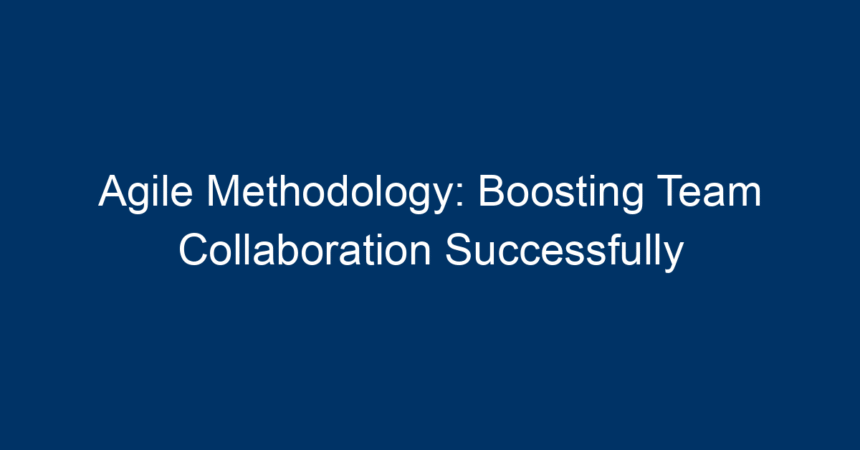In today’s fast-paced business environment, the ability to adapt and respond to changes is paramount for success. This is where Agile methodology comes into play, revolutionizing how teams collaborate and deliver projects. Originally developed for software development, Agile is now widely adopted across various sectors for its ability to foster communication, flexibility, and customer satisfaction. In this article, we will explore the principles behind Agile methodology, its core components, and how it significantly boosts team collaboration.
Understanding Agile Methodology
What is Agile Methodology?
Agile methodology is a framework that emphasizes iterative development, collaboration, and flexibility. It encourages teams to work in short cycles or "sprints," allowing for regular feedback and adjustments based on stakeholder input. Unlike traditional project management approaches that follow a linear path, Agile promotes a more dynamic and responsive way of working.
Key Principles of Agile
According to the Agile Manifesto, there are four core values that define Agile methodology:
-
Individuals and Interactions Over Processes and Tools: Prioritizing people and their collaboration can lead to more effective solutions than merely relying on processes.
-
Working Software Over Comprehensive Documentation: Delivering functional products is more valuable than extensive documentation that may quickly become outdated.
-
Customer Collaboration Over Contract Negotiation: Engaging with customers throughout the process ensures that the final product meets their actual needs.
- Responding to Change Over Following a Plan: Emphasizing flexibility allows teams to adapt and evolve based on real-time feedback.
These principles guide teams in harnessing Agile’s full potential for collaboration and productivity.
Benefits of Agile Methodology for Team Collaboration
1. Enhanced Communication
Agile methodology encourages open communication through daily stand-ups, sprint reviews, and retrospectives. These regular touchpoints foster a culture of transparency, allowing team members to share updates, address challenges, and align their goals. By breaking down silos and ensuring everyone is on the same page, Agile enhances overall team collaboration.
2. Flexibility and Adaptability
One of the strongest advantages of Agile methodology is its inherent flexibility. Teams can quickly pivot based on feedback and changing requirements, leading to more relevant outcomes. This adaptability not only enhances the end product but also empowers team members to contribute ideas and adapt their roles to meet evolving project needs.
3. Improved Problem-Solving
Agile encourages collaborative problem-solving by inviting team members to brainstorm solutions during collaborative sessions. By working together to tackle issues, teams build trust and rapport, creating a more cohesive unit. This collaborative spirit enables teams to leverage diverse perspectives, leading to more innovative solutions.
4. Increased Accountability
With Agile methodology, roles and responsibilities are clearly defined. Each team member knows what is expected of them and how their work impacts the overall project. This sense of accountability fosters dedication and ownership, as everyone is invested in achieving the goals set for the sprint.
Key Components of Agile Methodology
Understanding the structure of Agile is essential for promoting effective collaboration. Here are the key components that make up Agile methodology:
1. Scrum Framework
Scrum is one of the most popular Agile frameworks, characterized by specific roles, events, and artifacts. Scrum emphasizes iterative progress, allowing teams to break their work into manageable pieces known as sprints.
-
Roles: Scrum defines three key roles—Product Owner, Scrum Master, and Development Team—each with distinct responsibilities that foster seamless collaboration.
-
Events: Regular events like sprint planning, daily scrums, and sprint reviews promote continuous engagement among team members.
- Artifacts: Tools such as the product backlog and sprint backlog enhance transparency and communication within the team.
2. Kanban System
Kanban complements Agile methodology by visualizing work and limiting work in progress. The Kanban board serves as a visual representation of tasks, making progress transparent and encouraging team collaboration. Team members can easily see what needs to be done, what is in progress, and what has been completed.
3. Extreme Programming (XP)
Extreme Programming (XP) is another Agile approach that focuses on technical excellence and frequent releases. XP practices encourage paired programming and extensive testing, which enhance collaboration between developers, testers, and stakeholders.
Implementing Agile Methodology in Your Team
1. Start with Training
Before diving into Agile practices, it’s crucial for the team to receive adequate training. Understanding Agile principles and frameworks ensures everyone is aligned and ready to collaborate effectively.
2. Define Clear Roles
Establish clear roles that align with Agile practices. Assign a Product Owner who understands customer needs, a Scrum Master to facilitate the process, and a dedicated development team responsible for delivering high-quality results.
3. Emphasize Communication
Create an environment prioritizing open communication. Encourage daily stand-ups, regular check-ins, and an open-door policy for addressing challenges and ideas.
4. Leverage Tools
Utilize project management tools like Trello, Jira, or Asana that facilitate Agile workflows. These tools enhance collaboration by providing a centralized platform where everyone can track tasks and share updates.
5. Embrace Feedback
Adopt a mindset that welcomes feedback, both from team members and customers. Use retrospectives to reflect on what went well and what can be improved, fostering a culture of continuous improvement.
Challenges and How to Overcome Them
While Agile methodology yields numerous benefits, it may also come with challenges. Here are some common hurdles and suggestions for overcoming them:
Resistance to Change
Team members may resist shifting from traditional methodologies to Agile practices. To ease this transition, provide ongoing training and highlight the benefits of Agile through success stories.
Inconsistent Participation
In Agile, collaboration thrives on engagement. To ensure consistent participation, schedule regular meetings and emphasize their importance in achieving project success.
Misunderstanding of Roles
Ambiguity in roles can undermine collaboration. Clearly define each person’s responsibilities and the collaborative processes involved to enhance clarity in teamwork.
Conclusion: Actionable Insights for Boosting Collaboration Through Agile Methodology
The adoption of Agile methodology is not merely about implementing new processes; it is about cultivating a collaborative culture that enhances team effectiveness. To summarize the insights from this article:
-
Prioritize Communication: Create regular check-ins and encourage open dialogue among team members.
-
Be Adaptable: Embrace feedback and allow the team to pivot based on insights and changing requirements.
-
Define Roles Clearly: Ensure that responsibilities are well understood by each team member to avoid confusion.
-
Utilize Collaborative Tools: Implement project management software to streamline communication and task tracking.
- Foster a Culture of Continuous Improvement: Use retrospectives to reflect on processes and identify areas for growth.
By embracing Agile methodology and these actionable insights, teams can significantly enhance their collaboration, leading to improved project outcomes and overall success. Whether you’re a seasoned Agile practitioner or just starting the journey, the future of teamwork is bright with Agile’s collaborative power.




